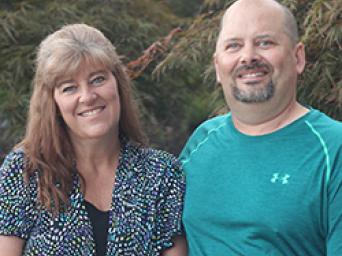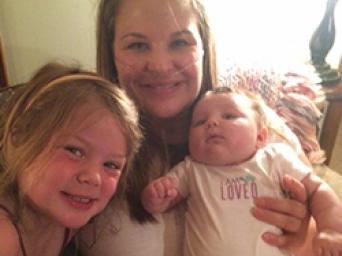Life, Supported
It was a few days into January 2016, and Mark Shuster was within hours of death.
His heart was beating less than 30 times each minute. His systolic blood pressure had dropped into the 50s. His heart wasn’t working, and his blood oxygen levels showed it.
A healthy person registers an oxygen level of 95 to 100 percent. Mark’s was so low that night on the operating table at Saint Luke’s Hospital of Kansas City that his surgical team couldn’t even get a reading.
Doctors had a plan to save him, but they would have to work fast.
Out of options
Mark was 43 years old when doctors diagnosed his hypertrophic cardiomyopathy, a rare genetic condition that causes the heart muscle to become abnormally thick.
He lived with mild but manageable symptoms for 15 years. He had become used to being short of breath as he walked up hills. Sometimes he’d feel dizzy if he rose too quickly. He started to develop occasional leg cramps. By the fall of 2015, this had become the new normal.
“It got to the point the cramps would happen every night, and they were really severe,” says Mark.
Well aware of the seriousness of his heart disease, Mark had already been seeing Charles Barth, M.D., at Saint Luke’s Cardiovascular Consultants. By December 2015, his symptoms had progressed to the point where Dr. Barth recommended he meet with a cardiothoracic surgeon. Mark never made it to that appointment.
A severe coughing fit overtook him on New Year’s Eve 2015. His girlfriend rushed him to Saint Luke’s South Hospital in Overland Park, Kansas. His condition rapidly deteriorated. Mark spent a few days there but he wasn’t getting better. The team stabilized him, and LifeFlight transported him to Saint Luke’s Hospital on the Plaza.
As his family prayed for a miracle, an emergency midnight call was made to Michelle Haines, M.D., a cardiac anesthesiologist and intensivist. Dr. Haines is director of Saint Luke’s Extracorporeal Membrane Oxygenation Program, or ECMO.
She realized Mark’s problems were caused by a failing mitral valve in his heart related to his disease. Surgery could fix it, but he was too weak to undergo an operation. By now, doctors were pushing epinephrine just to keep him alive.
“He was dying,” says Dr. Haines. “The only way we could do anything to help him was to put him on ECMO.”
Strength and hope
ECMO is an aggressive form of life support that could take over the full function of Mark’s heart and lungs and allow time to determine the next steps.
It was his best—and probably only—chance. It does not come without risks, but doctors met each complication with a solution.
“They did whatever it took,” Mark says. “That’s a testament to their commitment.”
Even with this life support, doctors feared the worst. Mark’s body had been starved of oxygen. Hours later, he was still completely unresponsive. Early in the morning, Dr. Haines checked on him again.
“Mark, if you can hear me, squeeze my hand,” she said. And he did.
After eight days of ECMO support, Mark had regained enough strength to undergo surgery. Cardiothoracic surgeon Alex Pak, M.D., replaced Mark’s mitral valve. The surgery was a success, and Mark was taken off ECMO.
Then he began the long road to recovery.
Future ahead
Mark spent a month in the CVICU and another two weeks doing inpatient rehabilitation. At one point, after he’d been through the worst of it, he looked out the window to the world beyond. He thought about the people he loved and how life might look now that he had a future again.
He promised himself, “I’m getting back out there.”
It took time and hard work. Mark had to re-learn such basic tasks as sitting, walking, and even brushing his teeth.
“It wasn’t until the very end that I could put my socks on,” he remembers. “That was one of the bigger challenges.” The nurses and rehabilitation team were with him, quite literally, every step of the way. Mark continued outpatient rehabilitation for several more months and claimed a full recovery after about a year.
“I had made the right choice years ago,” he says of choosing Saint Luke’s for his heart care. “I’ve used a huge amount of their resources and continue to. They literally saved my life.”
Mark still sees the team at Saint Luke’s Mid America Heart Institute for regular checkups, but at 60 years old he is living his life as fully as he can. He returned to his job as chief financial officer of the Jewish Federation of Kansas City. He hikes with his girlfriend. He spends precious days doting on his grandchildren.
Just like he envisioned in his hospital bed all those months ago.


